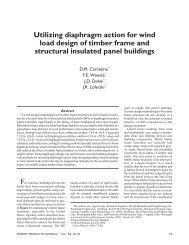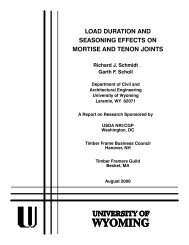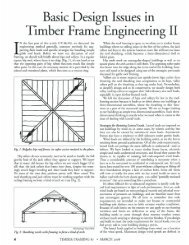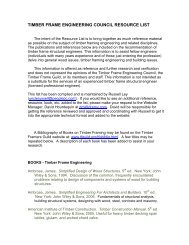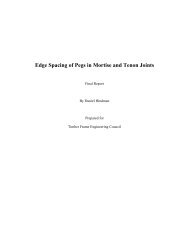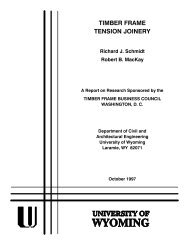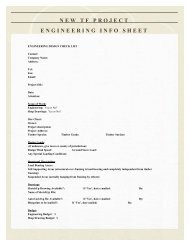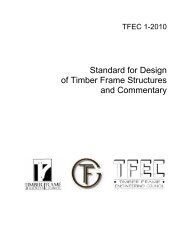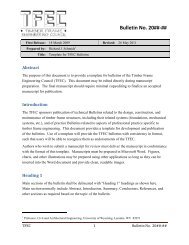Bulletin No. 20##-## - Timber Frame Engineering Council
Bulletin No. 20##-## - Timber Frame Engineering Council
Bulletin No. 20##-## - Timber Frame Engineering Council
You also want an ePaper? Increase the reach of your titles
YUMPU automatically turns print PDFs into web optimized ePapers that Google loves.
6000<br />
Load, lb<br />
5000<br />
4000<br />
3000<br />
2000<br />
MA-01<br />
MA-02<br />
MA-03<br />
MA-04<br />
MA-05<br />
MA-06<br />
MA-07<br />
MA-08<br />
MA-09<br />
radial<br />
loading<br />
tangential and<br />
diagonal loading<br />
1000<br />
0<br />
0 0.05 0.1 0.15 0.2 0.25<br />
Displacement, in<br />
Figure 1 – Dowel Bearing Behavior of Maple Pegs<br />
Tables<br />
Tables should be used to present data essential to the utility of the bulletin. Do not duplicate data<br />
in a table that is also illustrated in a figure or chart. The following points apply.<br />
• Number each table with an Arabic numeral and give it a title that is complete and<br />
descriptive. In column headings, first include the quantity being tabulated, then a<br />
comma, then the units, for example: "Tensile Strength, psi."<br />
• Do not use powers of 10 in the column heading, since it is not clear whether the numbers<br />
in the table have been or are to be multiplied by the power of ten. Instead, indicate the<br />
multiplication (for example, 1.45 x 10 6 ) in the first entry in the table, or use an expression<br />
such as "Young's Modulus, millions of psi" in the column heading.<br />
• For footnotes that appear in tables, use the style described in the Footnotes section.<br />
• Use horizontal rules under column headings. Use vertical rules only when the<br />
complexity of the table demands them for clarity. Use leaders (three periods) in any<br />
space that represents a blank entry.<br />
• Additional information can be included in a note that appears below the title.<br />
• When two (or more) separate systems of units are both listed in one table (for example,<br />
inch-pound and SI units), provide SI units in separate columns, in parentheses, or in<br />
brackets.<br />
• When the size of a table and limitations of space (on the printed page) make it impractical<br />
to expand the table to include SI unit equivalents, duplicate the table.<br />
TFEC 4 <strong>Bulletin</strong> <strong>No</strong>. 20XX‐XX




